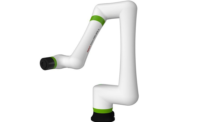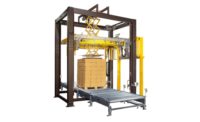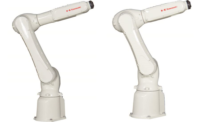Cover Story: Robotics, Controls & Automation
Clean application robots must meet high standards
Principles to consider when installing a clean robot.

When handling unpackaged food, like wheels of cheese, the entire robot and its system must be cleanable.

Robots in clean applications handle sensitive items like unpackaged food, pharmaceutical products or medical devices.

Robots in clean applications handle sensitive items like unpackaged food, pharmaceutical products or medical devices.

Industrial robots increase product quality, throughput efficiency and improve worker safety.

More and more robots are being used successfully in processing applications.





Industrial robots in packaging applications are generally performing traditional tasks like palletizing and case packing, known as secondary packaging. They also perform basic pick and place tasks like sorting, inspecting, inverting, stacking and pattern building. The entire system, including the robot, must be selected to accommodate the package, so many industrial robots are capable of performing these secondary packaging tasks. These applications constitute a mature market for industrial robots where reduced labor, operational flexibility, increased product quality, throughput efficiency, improved worker safety and smaller footprint are standard system benefits.
Clean robots provide more benefits
Let’s consider the use of robots in clean applications where they handle sensitive items like unpackaged food, pharmaceutical products or medical devices. These applications include primary packaging, product processing and medical procedures. These are neither traditional applications, nor are they a mature market for robots, but increasingly, robots are being used successfully in these applications to achieve the same system benefits as in secondary packaging.
A major incentive exists in clean applications that are not present in any other application: the elimination of the human involvement with the product means the elimination of a potential product contamination source. Now the system design specification dictates that the equipment, including the robot, cannot provide any contamination risk to the sensitive product or to the work area.
Many of these applications are performed in harsh environments, and as such, the equipment must be protected from the environment while still being able to perform at its full potential in these harsh conditions. In addition, these applications generally have a cleaning or sanitation process, a sterility protocol or a particle emission limit, along with requirements to conform to applicable industry standards.
This means that careful consideration for the robot selected must be made to ensure the continued integrity of the product and provide protection for the robot to preserve the investment in automation. One method is to consult the principles of clean design, which are general guidelines to prevent microbial growth in equipment and systems. Microbial growth requires oxygen (except anaerobic varieties), comfortable room temperatures, a midrange pH level and an energy or food source. These are common conditions in today’s manufacturing plants, so it is critical that the equipment and robot be maintained in a clean condition to slow or halt microbial growth.
Following are clean design principles to consider when selecting an industrial robot for use in clean applications.
Equipment must be cleanable to a microbiological level
To be considered “cleanable” the robot must be designed to facilitate easy cleaning, rinsing and draining.
For effective microbial growth control, it may be necessary to use cleaners, sterilizers or detergents that contain caustics or other aggressive chemicals. A fully enclosed, sealed robot design prevents particle emission into the environment and allows the surface to be saturated and cleaned without a concern for corrosion due to ingress of fluids. Smooth surfaces on the robot’s exterior promote draining so all remnants of cleaning solutions are drained away from exposure to the sensitive product. Checking chemical compatibility between cleaning solutions and the robot’s exterior will prevent any reactants from accumulating in the environment or from being exposed to the product. Most robot manufacturers have a list of compatible cleaners or ought to offer a laboratory evaluation to detail any reaction between cleaners and coatings for any that are not on their acceptable lists.
Frequently, an IP rating is quoted to indicate a robot design that is easy to clean, but IP rating refers to the robot’s level of protection from the environment. This does not indicate cleanability. Fully sealed, enclosed and smooth sides are cleanable regardless of the IP rating.
No product or liquid collection areas
Product or liquid collection areas include nooks, crannies, cracks, depressions or any area where contamination can collect and is not easy to remove by cleaning. A proper sanitary design cannot include any of these.
Prime locations that accumulate contamination in some robot designs include the shadow areas in the robot’s castings between joints, and anything external to the robot arm like springs, moving mechanisms, pneumatic tubing, tube bundles, valves, cables, cable standoffs, hangers and the interconnect cables from the robot to the controller. These external items accumulate contamination and require dismantling or special cleaning procedures. A proper sanitary design uses the robot’s internal pneumatic lines and internal wiring harness. Avoid anything external to the arm structure that provides liquid collection areas and complicates cleaning.
Sealing the robot base to its mounting surface closes any gaps and eliminates a potential product or liquid collection space to prevent the possibility of water wicking between these two surfaces and corrosion.
Many clean applications adhere to the drip, drain and draw rule. This rule states that liquids from the robot cannot be allowed to make contact with the product, nor enter an open container. Hence, overhead mounting of equipment is strongly discouraged, and in some instances, the use of drip trays over the product, or covers over open containers, are required.
Some robot manufacturers recommend the use of traditional robot covers to protect the robot, but these typically employ folds to allow freedom of motion, or elastic bands to provide a seal, therefore these covers actually introduce liquid collection areas. Another concern with covers is that the operator removes the cover for cleaning and reinstalls it. If this cover is not re-installed properly, the robot is not properly covered and can expose your product to the unprotected robot, and can also expose the robot to the environment.
Accessible for cleaning, sanitation, inspection and maintenance
Robots have the ability to move to various positions during cleaning and inspection, making hard to reach surfaces accessible. Of course, this needs to be performed and controlled in a safe manner per the current RIA (Robotic Industries Association; roboticsonline.org) safety standard.
The Robot Tooling must be removed for cleaning and inspection because this is a product contact surface and a critical component to safe product handling. Removal provides complete accessibility for cleaning and inspection.
A crucial part of any cleaning or sterilization protocol is inspection. In a fashion similar to the ease of cleaning a fully enclosed, sealed design with smooth sides vastly eases the inspection process.
Hygienically compatible with plant systems & able to operate in a sanitary condition
The robot should not require specialized cleaning agents and processes but should be sufficiently clean with the use of standard plant cleaning solutions and protocols. When the robot is put into production after proper cleaning, it must remain in a clean condition under normal operating circumstances.
Most robot manufacturers offer an NSF H1 food-grade lubrication option to provide hygienically compatible oils. Every effort is made in robot design to seal joints to eliminate lubrication leaks, but should one occur, these are food safe oils. In addition, the robot will require oil changes during its lifetime, and using a food safe oil means that during this maintenance procedure the sensitive environment is not exposed to non-hygienic traditional oils.
Validate cleaning & sanitizing protocols
A clean robot design must conform to the applicable environmental specs whether they define a particle emission limit, a sterility grade, a clean room class or other consideration. The entire system must have a defined and documented cleaning and sanitation regimen that is proven effective in protecting the product and maintaining the equipment per the applicable environmental specifications.
Standards exists to define these environmental constraints like ISO cleanroom specs and cleaning specs exist like the Robot Based Automation Standard currently being developed by the 3-A Sanitary Standards Institute (3-A.org) defining robot sanitation requirements in dairy and other food applications. Validation of conformance to standards must be performed and documented per the applicable standard directive.
In summary, clean applications, like primary packaging, represent a huge growth potential for the industrial robotics industry. But these are non-traditional robot applications, therefore not all robot manufacturers design robots for these applications, and not all integrators are equipped to handle these demands successfully. Eliminate any risk of contamination by adhering to these clean design principles and by conforming to the appropriate industrial standard for the application.
In clean robotic applications, we at Staubli protect the product with clean system designs just like we protect the person with system safety designs.
Stäubli (staubli.com) is a leading manufacturer of textile machinery, quick release couplings and robotics systems. With a workforce of over 4000 employees Stäubli is present in 25 countries supported by a comprehensive distribution network in 50 countries worldwide. Stäubli’s North American headquarters is located in Duncan, SC and has over 200 employees supporting Textile, Connectors and Robotics customers, with a dynamic sales force strategically placed on the West Coast, Canada, Mexico, and elsewhere throughout the continent.
Looking for a reprint of this article?
From high-res PDFs to custom plaques, order your copy today!












